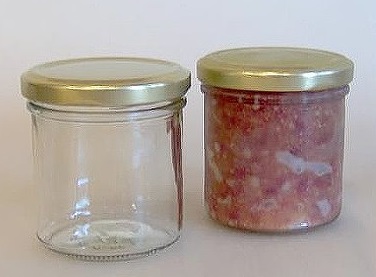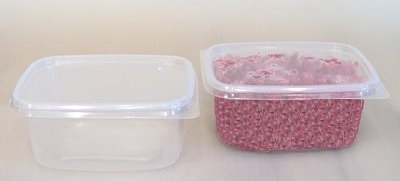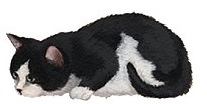

There are many ways of storing and preserving foods
Most methods significantly reduce the nutritional value of foods, and only freezing and freeze drying are able to preserve food nearly unchanged in nutritional quality. To store your homemade, raw meat cat food, you must freeze it – unless you are in a position to use what you have prepared within a day.
Containers which have proven useful for freezing your cat’s homemade food are:
 Glass jars
Glass jars
Small, glas jars are a great alternative for people who dislike the storage of food in plastic containers. Glass jars have the same properties as plastic containers for storing and freezing your cat food, with the exception that glass needs to be handled with greater care to prevent breakage. By the way, jars aid in protecting the food from freezer burn. Personally, we ourselves like using wide-mouth, glass freezer jars for storing our home made, raw meat cat food. The only thing we periodically have to replace are the metal lids. Over time, they tend to get worn out.
 Small, plastic freezer containers
Small, plastic freezer containers
Available in a variety of brands and sizes, these containers enable you to neatly freeze your cat’s food pre-portioned. The portions easily thaw in these containers and form an attractive pudding when turned onto your cat’s dinner plate.
Tupperware
These containers are dishwasher safe, can be sterilized in boiling water, and last for years.
Zip-Bags/Freezer-bags
Small freezer bags are great for space saving storage of the food in your freezer and extremely convenient for thawing. Fill the freezer bag with the desired amount of food and flatten out the food to fill the entire space in the bag. This will form easy to stack “sheets” of frozen cat food in your freezer which thaw in minutes if floated
in a water bath. Freezer bags make great packaging solutions for those of us who cannot get used to remembering to take out frozen cat food the day before for thawing in the refrigerator. The drawback of freezer bags is that they are not re-useable
Ice cube trays
Ice cube trays find their greatest application during the transition period, when your cat might not eat full portions of the homemade food, yet. Freezing the homemade cat food as ice cubes enables you to thaw small quantities of food fresh every day and prevent waste. It is best to use the ice cube trays to rapidly freeze the food in the desired portion, and then to store the frozen cat food cubes loose in freezer bags for longer storage. To thaw, simply place the frozen cubes on your cat’s dinner plate and leave in the refrigerator over night.
Label containers
Put a small label on each container with the food type (i.e., chicken, beef, lamb, rabbit,) and the date that the container is placed in storage to know which containers contain the questionable batch.
These methods are those which we have the most personal experience with. Maybe you will find another way more useful for your own situation. Those of you with 2 or cats or more don’t actually have to freeze the food at all. On the other hand, you may find it more convenient to multiply the recipe and prepare enough food to last a month. How you decide to do this, however, depends on how many cats you are feeding and how much they eat daily, which can vary from cat to cat
Please note
Never serve the cat food cold straight from the refrigerator.
![]()
What Can You Freeze?
You can freeze almost any food. Some exceptions are canned food or eggs in shells. However, once the food (such as a ham) is out of the can, you may freeze it. Being able to freeze food and being pleased with the quality after defrosting are two different things. Some foods simply don’t freeze well. Examples are mayonnaise, cream sauce and lettuce. Raw meat and poultry maintain their quality longer than their cooked counterparts because moisture is lost during cooking.
Is Frozen Food Safe?
Food stored constantly at -22 degree Celsius will be safe. Only the quality suffers with lengthy freezer storage. Freezing keeps food safe by slowing the movement of molecules, causing microbes to enter a dormant stage. Freezing preserves food for extended periods because it prevents the growth of microorganisms that cause
both food spoilage and foodborne illness.
Does Freezing Destroy Bacteria & Parasites?
Freezing to -22 degree Celsius inactivates microbes – bacteria, yeasts and molds – present in food. Once thawed, however, these microbes can again become active, multiplying under the right conditions to levels that can lead to foodborne illness. Since they will then grow at about the same rate as microorganisms on fresh food, you must handle thawed items as you would any perishable food. Thorough cooking will destroy all parasites.
Freshness & Quality
Freshness and quality at the time of freezing affect the condition of frozen foods. If frozen at peak quality, foods emerge tasting better than foods frozen near the end of their useful life. So freeze items you won’t use quickly sooner rather than later. Store all foods at -22 degree Celsius or lower to retain vitamin content, color, flavor and
texture.
Nutrient Retention
The freezing process itself does not destroy nutrients. In meat and poultry products, there is little change in nutrient value during freezer storage.
Freezer Burn
Freezer burn does not make food unsafe, merely dry in spots. It appears as grayish-brown leathery spots and is caused by air reaching the surface of the food. Cut freezer-burned portions away either before or after cooking the food. Heavily freezer-burned foods may have to be discarded for quality reasons.
Freeze Rapidly
Freeze food as fast as possible to maintain its quality. Rapid freezing prevents undesirable large ice crystals from forming throughout the product because the molecules don’t have time to take their positions in the characteristic six-sided snowflake. Slow freezing creates large, disruptive ice crystals. During thawing, they damage the cells and dissolve emulsions. This causes meat to “drip”– lose juiciness. Ideally, a food 2-inches thick should freeze completely in about 2 hours. If your home freezer has a “quick-freeze” shelf, use it. Never stack packages to be frozen. Instead, spread them out in one layer on various shelves, stacking them only after frozen solid.
Safe Defrosting
Never defrost foods in a garage, basement; out on the kitchen counter, outdoors or on the porch. These methods can leave your foods unsafe to eat. It’s best to plan ahead for slow, safe thawing in the refrigerator. Small items may defrost overnight; most foods require a day. For faster defrosting, place food in a leak proof plastic bag and immerse it in cold water.


 Deutsch
Deutsch
